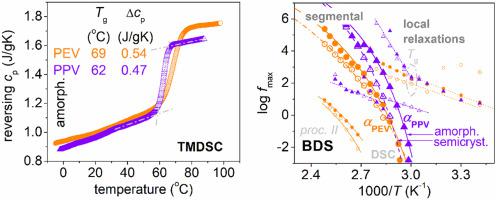Polymer ( IF 4.1 ) Pub Date : 2021-09-17 , DOI: 10.1016/j.polymer.2021.124197 Eleftheria Xanthopoulou 1, 2 , Panagiotis A. Klonos 1, 3 , Alexandra Zamboulis 1 , Zoi Terzopoulou 1 , Apostolos Kyritsis 3 , Polycarpos Pissis 1 , Dimitrios N. Bikiaris 1 , George Z. Papageorgiou 2, 4

|
In this work, the molecular mobility of two relatively new biobased polyesters poly(ethylene vanillate) (PEV) and poly(propylene vanillate) (PPV) is investigate. The importance of these polymers lays on their renewable character, a desired property of today's global needs, along with the fact that are derived from vanillin, trough vanillic acid, a product of lignin. The latter is the second most abundant polymer on earth. Broadband dielectric spectroscopy (BDS) supplemented by differential scanning calorimetry (DSC, TMDSC), polarized light microscopy (PLM) and nuclear magnetic resonance are the main investigation tools. The molecular mobility mapping, for both local and segmental dynamics of PEV and PPV, is shown here for the first time. Beginning with calorimetry, in the amorphous state, the glass transition temperature, Tg, of PEV and PPV was found 69 and 62 °C, respectively, while the corresponding heat capacity change was found 0.54 and 0.47 J/g∙K. A variety of relaxation processes were recorded in BDS, namely the local γ, β1 and β2, the segmental α relaxation, the dielectric analogue of glass transition, and additional processes revealed by the employed analysis. We propose possible molecular origins for the local γ, β1 and β2 relaxations, namely, on side groups rotation and crankshaft motions on the backbone. The latter is suggested by the recorded changes in time scale at specific temperature regions, for example, around Tg for β2, which seems to be a common characteristic between some polyesters. Segmental α relaxation was found to be in accordance with the calorimetric Tg, i.e., faster for PPV, while the dielectric Tgs were found 64 °C and 59 °C, for PEV and PPV, respectively. In the amorphous state, α is less fragile and slightly stronger in PEV, whereas its time-scale is less affected by cold crystallization, in contrast to that of PPV. From the overall results, indications for differences in the interchain distances and chain-chain interactions, along with the effects by the chain length were revealed. These parameters were correlated with the retarded crystals nucleation in the case of the short PEV chains as compared to PPV.
中文翻译:

生物基聚(乙烯香草酸酯)和聚(丙烯香草酸酯)的分子迁移率研究
在这项工作中,研究了两种相对较新的生物基聚酯聚(乙烯香草酸酯)(PEV)和聚(丙烯香草酸酯)(PPV)的分子迁移率。这些聚合物的重要性在于它们的可再生特性,这是当今全球需求的理想特性,以及源自香草醛、香草酸(木质素的产物)的事实。后者是地球上第二丰富的聚合物。宽带介电光谱(BDS)辅以差示扫描量热法(DSC、TMDSC)、偏光显微镜(PLM)和核磁共振是主要的研究工具。此处首次显示了 PEV 和 PPV 的局部和分段动力学的分子迁移率映射。从量热法开始,在无定形状态下,玻璃化转变温度,PEV 和 PPV 的T g分别为 69 和 62 °C,而相应的热容变化为 0.54 和 0.47 J/g∙K。在 BDS 中记录了多种弛豫过程,即局部γ、β 1和β 2、分段α弛豫、玻璃化转变的介电类似物,以及所采用的分析揭示的其他过程。我们提出了局部γ、β 1和β 2 的可能分子起源松弛,即侧群旋转和主干上的曲轴运动。后者是通过在特定的温度区域中的时间尺度所记录的变化,例如,围绕建议Ť克为β 2,这似乎是一些聚酯之间的共同特征。发现分段α弛豫与量热T g 一致,即PPV 更快,而PEV 和PPV的介电T g s 分别为64°C 和59°C。在非晶态下,α与 PPV 相比,它在 PEV 中不那么脆弱且稍强,而其时间尺度受冷结晶的影响较小。从总体结果中,揭示了链间距离和链间相互作用差异的迹象,以及链长的影响。与 PPV 相比,在短 PEV 链的情况下,这些参数与延迟晶体成核相关。











































 京公网安备 11010802027423号
京公网安备 11010802027423号